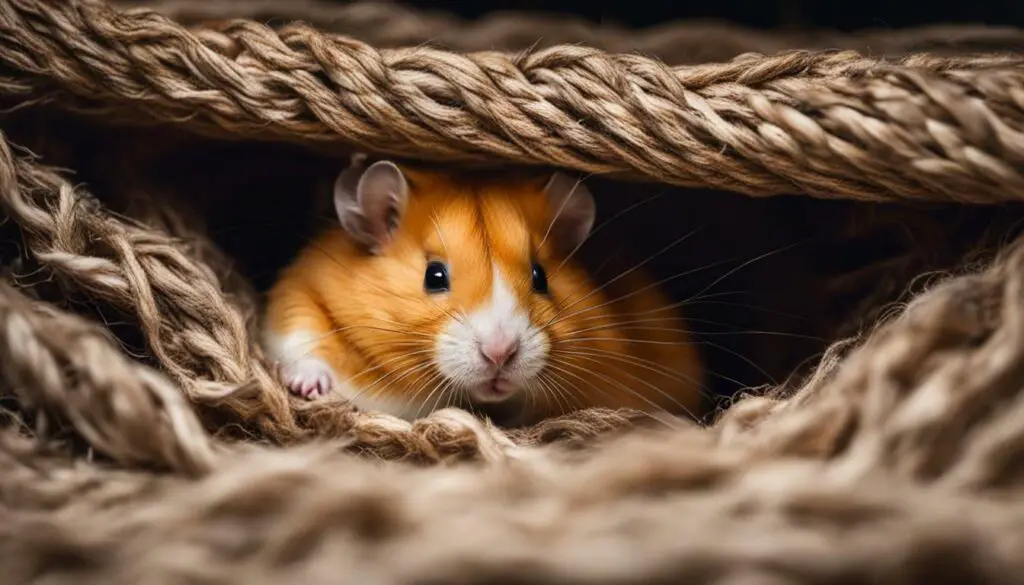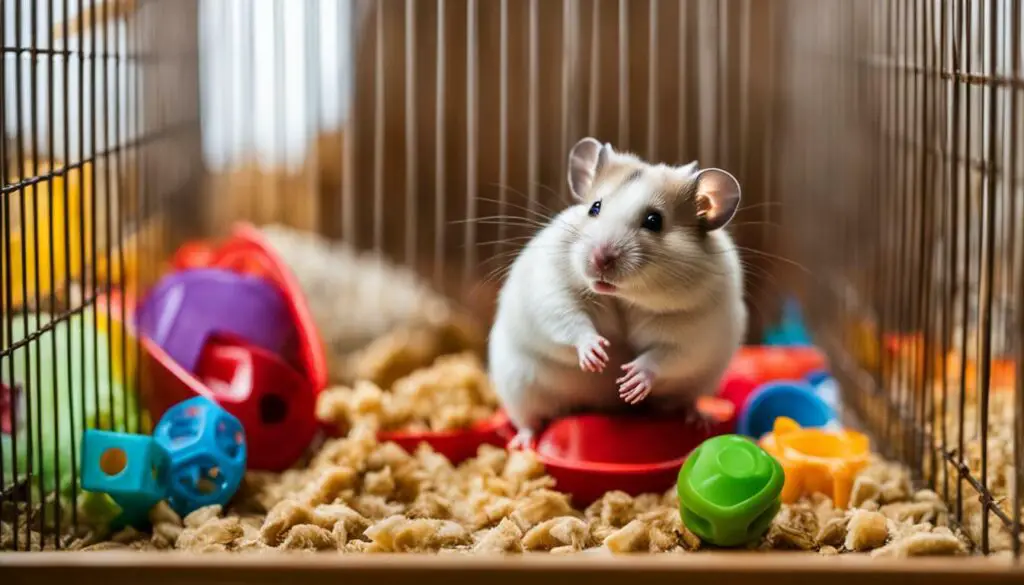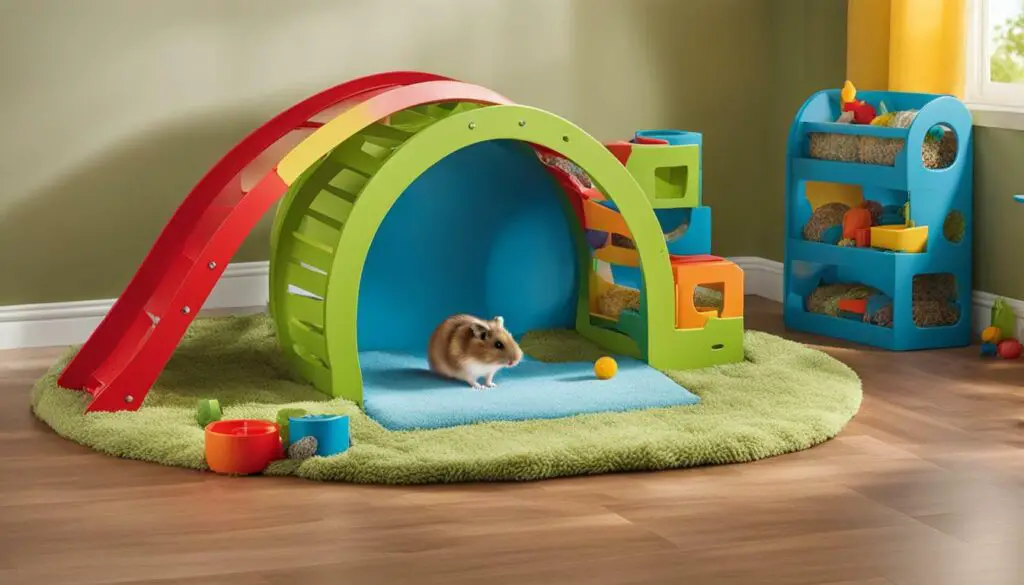Hamsters are known for their solitary nature, but do they get lonely? As social animals ourselves, it’s natural to wonder if our fluffy little friends experience feelings of isolation. Let’s dive into the social behavior of hamsters and explore whether they need companionship.
Hamsters, particularly Syrian hamsters, have a strong preference for living alone. In fact, they are territorial creatures who will fight if housed with another hamster. This behavior is rooted in their origins as desert animals, where protecting their territory and resources is crucial to survival.
On the other hand, dwarf hamsters can tolerate some companionship, but it’s important to introduce them at a young age. When bringing two hamsters together, it’s recommended to keep them in separate cages initially and gradually introduce them while closely supervising their interactions. This gradual approach helps prevent any aggression and allows the hamsters to get accustomed to each other’s presence.
But here’s the thing – hamsters do not necessarily need a friend to be happy. They are content with human companionship and can thrive with appropriate care. Providing them with a suitable habitat, toys for mental stimulation, and a balanced diet are key factors in keeping them happy and healthy.
Key Takeaways:
- Hamsters are solitary animals, with Syrian hamsters preferring to live alone and dwarf hamsters having a higher tolerance for companionship.
- When introducing two hamsters, separate enclosures and gradual introductions are necessary to prevent aggression.
- Hamsters do not require another hamster as a friend and can thrive with human companionship.
- Creating a suitable habitat, providing stimulating toys, and offering a balanced diet are essential for hamster well-being.
- Be observant of signs of loneliness or behavioral changes, and take steps to provide mental stimulation and prevent loneliness.
Understanding Hamster Behavior
To understand whether hamsters get lonely, it’s important to explore their behavior and natural inclinations. Hamsters are solitary animals that have evolved to protect their territory and resources. They were originally desert animals, which explains their independent nature and preference for solitude.

Hamsters have specific habits and a unique lifestyle. They are most active during the night and spend their days sleeping. They have a natural instinct to hoard food and create elaborate burrows for themselves. These burrows serve as their safe haven and provide them with a sense of security. Hamsters are also known for their strong sense of smell, which helps them navigate their environment and identify potential threats.
Hamster Social Needs
While hamsters are solitary by nature, they still have social needs. Although they do not require companionship from other hamsters, they can still thrive with appropriate human interaction. Regular handling and gentle interaction with your hamster can provide them with mental stimulation and help prevent loneliness. Building a bond with your hamster through playtime and treats can create a positive relationship and foster their overall well-being.
| Hamster Habits | Lifestyle | Social Needs |
|---|---|---|
| Active at night | Prefer solitude | Thrive with human companionship |
| Hoarding food | Create elaborate burrows | Regular handling and interaction |
| Strong sense of smell | Protect territory and resources | Building a bond through playtime |
By understanding the natural habits, lifestyle, and social needs of hamsters, we can provide them with an enriching and fulfilling environment. Remember to provide them with a suitable habitat, including toys for mental stimulation and an appropriate diet to ensure their happiness and overall well-being.
Solitary Nature of Syrian Hamsters
Syrian hamsters, also known as golden hamsters, have a strong preference for living alone and do not require companionship. These adorable creatures are naturally territorial and will fiercely defend their territory and resources from intruders. In the wild, Syrian hamsters have extensive burrow systems where they create their own personal space.

It is important to understand that housing two Syrian hamsters together can lead to aggressive behavior, resulting in injuries or even death. As solitary animals, they are not accustomed to sharing their living space and resources with others. Therefore, it is essential to provide them with separate cages to prevent any confrontation and maintain their overall well-being.
Table: Recommended Cage Size for Syrian Hamsters
| Hamster Type | Minimum Cage Size |
|---|---|
| Syrian Hamster | At least 450 square inches (2900 square cm) |
When it comes to providing enrichment and stimulation, Syrian hamsters do not rely on social interaction with other hamsters. Instead, they enjoy human companionship and can form strong bonds with their owners. Spending quality time with your hamster, providing them with a suitable habitat, a variety of toys, and a balanced diet are crucial in keeping them happy and content.
Remember, every hamster is unique, and their individual needs should be considered. Pay attention to their behavior and make adjustments to their environment accordingly. By respecting their solitary nature and providing a fulfilling environment, you can ensure the well-being and happiness of your Syrian hamster companion.
Dwarf Hamsters and Companionship
Unlike Syrian hamsters, dwarf hamsters can tolerate some companionship, but it’s important to introduce them properly. Dwarf hamsters are social animals that can benefit from the presence of another hamster, as long as they are introduced at a young age. Social interaction can provide mental stimulation and enhance their overall well-being.
When introducing two dwarf hamsters, it’s crucial to follow a gradual and supervised process. Initially, it’s recommended to keep them in separate cages to prevent any aggressive behavior. This allows each hamster to establish their own territory and become familiar with their surroundings.
As they become more comfortable, you can slowly introduce them to each other in a controlled environment. This can be done by placing their cages side by side for a period of time, allowing them to interact through the bars. Observe their behavior closely to ensure they are getting along and not showing signs of aggression.
Once they have successfully interacted through the bars, you can try introducing them in a neutral territory, such as a playpen or a large, neutral cage. Keep a close eye on their interactions and be ready to separate them if any signs of aggression or stress occur. Patience and consistency are key in facilitating a positive introduction process for dwarf hamsters.

Providing dwarf hamsters with companionship can have several benefits. It can help prevent loneliness and provide mental stimulation, as they engage in playful activities and mimic natural social interactions. Companionship can also promote exercise and encourage natural behaviors, such as grooming and social grooming.
| Benefits of Dwarf Hamster Companionship: |
|---|
| Prevents loneliness |
| Provides mental stimulation |
| Encourages natural behaviors |
| Promotes exercise |
Introducing Two Hamsters
Introducing two hamsters requires careful steps to ensure their safety and prevent any potential aggression. Hamsters are solitary animals by nature, but dwarf hamsters can tolerate some companionship if introduced at a young age. However, Syrian hamsters prefer to live alone and will fight if housed with another hamster. To avoid any conflicts, it is important to follow proper guidelines for introducing two hamsters.
Separate Cages
When introducing hamsters, it is recommended to keep them in separate cages initially. This allows them to become familiar with each other’s scent and presence without direct contact. Providing each hamster with their own space helps prevent territorial disputes and reduces the likelihood of aggression. Once they have grown more comfortable, you can gradually introduce them to one another in a neutral and controlled environment.
Supervision and Preventing Aggression
Supervision is crucial during the introduction process to observe their behavior and prevent any aggression. Small steps should be taken, such as allowing them to interact in a neutral space while closely monitoring their interactions. If any signs of aggression or fighting occur, it is important to separate them immediately to prevent injuries.
Remember, hamsters are naturally solitary creatures, and not all of them will have a desire for companionship. It is essential to respect their individual preferences and prioritize their well-being. Providing them with a suitable habitat, toys for stimulation, and a balanced diet can keep them happy and healthy even without a hamster companion.
| Tips for Introducing Two Hamsters |
|---|
| Keep hamsters in separate cages initially |
| Allow them to become familiar with each other’s scent before direct contact |
| Gradually introduce them in a neutral and controlled environment |
| Supervise their interactions to prevent aggression |
| Separate immediately if fighting or aggression occurs |

While hamsters don’t need a friend, they can thrive with human companionship and a well-designed habitat. Providing your hamster with the right environment and interaction is essential for their happiness and overall well-being. A suitable habitat for your furry friend should include a spacious cage with bedding, hiding spots, and toys for mental stimulation. It is also crucial to offer them a balanced diet consisting of hamster pellets, fresh vegetables, and occasional treats.
Interacting with your hamster on a daily basis is important for their mental health. Gently handling and playing with them will help build a bond and provide the social interaction they need. Remember to always approach your hamster with patience and care, as they can be easily startled. A quiet and calm environment is ideal for your hamster to feel safe and comfortable.
In addition to spending quality time together, adding toys to their environment will keep them entertained and prevent boredom. Hamsters love to chew, so providing them with chew toys made from safe materials will help keep their teeth healthy and satisfy their natural instincts. Exercise options such as hamster wheels or tunnels are also great for promoting physical activity.
| Hamster Happiness Tips |
|---|
| 1. Create an enriching environment: Provide a spacious cage with hiding spots, toys, and a variety of playthings to keep your hamster mentally stimulated. |
| 2. Handle with care: Interact with your hamster daily, but always approach them gently and with patience to avoid causing stress or fear. |
| 3. Offer a balanced diet: Ensure your hamster’s diet includes a mix of hamster pellets, fresh vegetables, and occasional treats. |
| 4. Provide chew toys: Hamsters love to chew, so provide safe chew toys to keep their teeth healthy and satisfy their natural instincts. |
| 5. Encourage physical activity: Incorporate exercise options like a hamster wheel or tunnels to keep your hamster active and prevent obesity. |
By following these tips and providing companionship in the form of gentle handling, a suitable habitat, and interactive playtime, you can ensure that your hamster is happy and content. Remember that each hamster has its own unique personality, so pay attention to their preferences and adjust their environment accordingly. With proper care and attention, your hamster will thrive and bring joy to your life.

It’s important to recognize the signs that your hamster might be feeling lonely or bored. While hamsters are generally independent animals, they still require mental stimulation and social interaction to thrive. When a hamster is feeling lonely, their behavior may change in noticeable ways. Keep an eye out for the following behavioral changes:
- Increased sleep: A lonely hamster may spend more time sleeping as a way to escape boredom and loneliness. If you notice your hamster sleeping more than usual, it could be a sign that they are feeling isolated.
- Aggressive behavior: Hamsters that are feeling lonely may become more aggressive towards their cage mates or even towards you. They may bite, nip, or exhibit other signs of aggression as a result of their frustration and lack of social interaction.
- Excessive chewing or digging: Loneliness can lead to anxiety and restlessness in hamsters. If you notice your hamster engaging in excessive chewing or digging behaviors, it may be a sign that they are trying to cope with their feelings of loneliness.
- Decreased appetite: A hamster that is feeling lonely may lose interest in food and show a decrease in appetite. This can be a result of their overall unhappiness and lack of mental stimulation.
Recognizing these signs will help you take the necessary steps to prevent loneliness and improve your hamster’s well-being.

| Signs of a Lonely Hamster | Behavioral Changes |
|---|---|
| Increased sleep | A hamster that sleeps more than usual may be feeling lonely. |
| Aggressive behavior | Loneliness can lead to increased aggression towards cage mates or their human caretakers. |
| Excessive chewing or digging | Hamsters may engage in these behaviors as a way to cope with their feelings of loneliness. |
| Decreased appetite | A hamster that is lonely may show a decreased interest in food. |
Takeaways
“While hamsters are generally independent animals, they still require mental stimulation and social interaction to thrive.”
Understanding the signs of a lonely hamster is crucial for ensuring your furry friend’s well-being. If you notice any of these behavioral changes, it’s important to take action. Provide your hamster with plenty of toys and activities to keep them mentally stimulated, and consider spending more quality time with them to provide the social interaction they need. Remember, a happy and engaged hamster is a healthy hamster!
Tips for Keeping Hamsters Happy
To ensure your hamster’s mental health and overall happiness, there are several steps you can take. While hamsters are solitary animals that do not require companionship, they still benefit from socialization and environmental enrichment. Here are some tips to help you prevent loneliness and bond with your furry friend:
- Provide regular interaction: Spend time with your hamster daily, talking to them in a soothing voice and offering gentle petting. This will help your hamster feel secure and build trust.
- Create an enriching habitat: Set up a habitat that includes hideouts, tunnels, and toys. Hamsters love exploring and having a variety of items to interact with will keep them mentally stimulated.
- Offer a balanced diet: Provide a diet that includes a mix of hamster pellets, fresh vegetables, and occasional treats. A healthy diet is essential for their well-being, and treats can be used as training rewards to reinforce positive behavior.
- Establish a consistent routine: Hamsters thrive on routine, so try to provide meals, playtime, and cleaning sessions at the same time each day. This helps them feel secure and reduces stress.
- Introduce new experiences gradually: When introducing new toys or activities, do so slowly to avoid overwhelming your hamster. Start with one new item at a time and observe their reaction before adding more.
Hamster Bonding
Bonding with your hamster is an important part of ensuring their happiness. While they may not seek out constant human interaction like some other pets, they still benefit from a positive and nurturing relationship with their owners. Here are some ways to strengthen the bond with your hamster:
- Hand-feed treats: Offering treats from your hand will help your hamster associate you with positive experiences. Gradually, they will become more comfortable approaching you and even climbing onto your hand.
- Play gentle games: Use interactive toys, such as tunnels or balls, to engage your hamster in playtime. This not only provides mental stimulation but also strengthens the bond between you.
- Respect their boundaries: Hamsters have their own individual personalities and preferences. It’s important to recognize when your hamster wants alone time and give them the space they need.
By following these tips and providing a nurturing environment, you can ensure your hamster’s mental health and overall happiness. Remember, each hamster is unique, so take the time to observe and understand their individual needs and preferences. With love and care, your hamster will thrive by your side.
| Hamster Mental Health: | Socialization, Preventing Loneliness, Hamster Bonding |
|---|
Creating an Enriching Environment
A well-designed habitat plays a crucial role in keeping your hamster stimulated and content. Providing a variety of enrichments, such as toys, hiding spots, and exercise options, can help meet their physical and mental needs.
When it comes to selecting toys for your hamster, opt for ones that encourage natural behaviors and promote exploration. Chew toys made from safe materials, such as wood or cardboard, are essential for maintaining dental health and preventing boredom. You can also include tunnels, ladders, and platforms to create a dynamic and interactive environment.
Hiding spots are crucial for hamsters, as they mimic the natural burrows they would create in the wild. These can include igloos, small houses, or even homemade cardboard hideouts. Providing multiple hiding spots throughout the habitat allows your hamster to feel secure and retreat to their own space whenever they need a break.
Exercise is essential for your hamster’s physical well-being. Including a hamster wheel or exercise ball in their habitat gives them the opportunity to burn off energy and engage in natural running behaviors. Just make sure to choose a wheel or ball that is the appropriate size for your hamster’s breed to prevent any injuries.

| Enriching Hamster Habitat Checklist |
|---|
| Provide a variety of safe chew toys |
| Incorporate tunnels, ladders, and platforms |
| Include multiple hiding spots |
| Offer an exercise wheel or ball |
Remember to regularly rotate and refresh the enrichments in your hamster’s habitat to keep them engaged and prevent boredom. They will appreciate the novelty and variety, just like they would encounter in their natural environment.
Conclusion
To conclude, hamsters are solitary creatures, but with the right care and attention, they can live happy and fulfilling lives in the company of their human caregivers. While hamsters do not experience loneliness in the same way humans do, they still require social interaction and mental stimulation to thrive.
It is important to remember that Syrian hamsters, the most common type of pet hamsters, prefer to live alone and can become aggressive if housed with another hamster. On the other hand, dwarf hamsters have a higher tolerance for companionship, but it is crucial to introduce them at a young age to ensure compatibility.
When introducing two hamsters, it is recommended to keep them in separate cages initially and gradually introduce them while closely supervising their interactions. This helps prevent any potential aggression and allows the hamsters to get used to each other’s presence.
While hamsters do not necessarily need another hamster as a friend, they can still benefit from human companionship. Providing a suitable habitat with plenty of toys for mental stimulation, hiding spots for privacy, and a balanced diet are all essential for keeping your hamster happy and healthy.
By understanding and meeting their social needs, you can ensure that your hamster lives a fulfilling and content life in your company. So, enjoy the companionship of your hamster and create an enriching environment that caters to their unique needs.
FAQ
Do hamsters get lonely?
Hamsters are solitary animals that do not get lonely. They are naturally inclined to live alone and have evolved to protect their territory and resources.
Are Syrian hamsters social animals?
No, Syrian hamsters are solitary animals and prefer to live alone. They will fight if housed with another hamster.
Can dwarf hamsters have companions?
Yes, dwarf hamsters can tolerate some companionship. It is important to introduce them to a companion at a young age.
How should I introduce two hamsters?
It is recommended to keep the hamsters in separate cages initially and slowly introduce them to one another. Supervision is necessary to ensure they are getting along and to prevent any aggression.
Do hamsters need a friend?
No, hamsters do not need a friend. They are content with human companionship. It is important to provide them with a suitable habitat, toys for stimulation, and a balanced diet to keep them happy and healthy.
How can I tell if my hamster is lonely?
Signs of a lonely hamster may include behavioral changes such as increased aggression, excessive grooming, or lethargy.
How can I keep my hamster happy?
To keep your hamster happy, ensure they have social interaction, a stimulating environment, and opportunities for exercise. Bonding with your hamster through gentle handling is also important.
What can I do to create an enriching habitat for my hamster?
Creating an enriching environment for your hamster involves providing toys, hiding spots, and exercise options. This will help keep them mentally and physically stimulated.
Can hamsters thrive with human companionship?
Yes, hamsters can thrive with appropriate human companionship. While they are solitary animals, they benefit from interaction and care from their human caregivers.




